The Best Heat-Tolerant Annuals for Beautiful Flower Blooms
Annuals have some of the most colorful blooms and foliage you can find in the garden – it’s why they’re so beloved! But with hot summers and heat waves becoming the norm, many of us want to know which annuals can withstand heat the best.
If you’re looking to create a flower bed or container garden full of annual plants and flowers, this list will give you plenty of beautiful choices so you won’t have to sacrifice on beauty!
(This post may contain affiliate links).
And let’s face it – we need our flowers to be able to beat the heat as well as bloom all summer long.
Annuals, thankfully, are easy to grow and are perfect for beginner gardeners. Plus, they’re an excellent choice for filling containers along your front door, porch, balcony, and front yard.
Plenty of annuals have a long bloom time, with many blooming from spring to the first frost. With the heat-resistant plants on this list, there’s no need to stick to solely full-sun succulents or tough ornamental grasses.
As much as I love succulents, I personally don’t want to go without beautiful flowers blooming in my summer garden!
So if you intend to plant annuals in direct sunlight, these picks are your best bet for creating arrangements that not only pop but pull through on those days when temps reach above 90 degrees.
Fortunately for us, these heat-loving annuals provide lots of color and texture, which means you’ll have a lovely display for months on end!
Below I’m going to cover some important care tips for keeping your annuals looking good during intense heat.
Tips for Growing Heat-resistant Annuals
Watering Annuals Sufficiently
While the annuals on this list are tough plants, you can’t let them fend for themselves during extreme heat for days at a time; they’ll need your help to flourish in high temperatures.
The most important thing you’ll want to get right is watering.
Many annuals love moist, well-draining soil so make sure to water frequently in the summer. They should be watered about every other day to every day when temperatures rise.
TIP: Try putting yourself on a watering schedule! Make sure to touch the soil and check for moisture at least every other day. This way, you never let your annuals suffer from heat exhaustion.
Checking so often might seem excessive to you now, but remember that the summer sun can zap all the moisture from the soil from one day to the next. Also, it’s best to water plants in the early morning before the heat sets in.
If you live in a dry climate like I do, then this is especially important; we can’t count on rain or humidity to help us out!
While some annual flowers on this list might be drought-resistant, they’ll still perform best when watered regularly.
Always keep in mind that even though a plant might survive drought conditions, it likely won’t look its best when dehydrated.
For the prettiest garden beds, keep your flowers as stress-free as possible and they’ll reward you with beautiful blooms and vibrant color.
Also, aim to use well-draining soil, especially if you live in a climate that gets lots of rainstorms in the summer.
This will help prevent water-logged soil that can lead to diseases like powdery mildew, fungus, and garden pests. Some flowers can grow in poor soil conditions, but many cannot.
Full Sun for Better Blooms
These sun-loving annuals need at least 6 hours of direct sunlight. They’ll produce their best blooms with the help of the sun, so try not to plant them in a shady area of your garden.
Too much shade might encourage plenty of foliage but very few flower buds and blooms.
Container size
Opt for larger containers – as large as your desired aesthetic and garden plans can accommodate. Small pots and containers dry out quickly, which means more work for you!
Larger pots can hold more soil, so they’ll retain more water for longer. Larger pots also give you the opportunity to plant more annuals together and thus create a show-stopping arrangement that you can show off on your front porch!
Deadhhead to Encourage More Flower Bloom Production
Annuals can bloom all summer long and into the fall season but you’ve got to deadhead the spent blooms. Snipping off blooms that have turned brown encourages the plant to produce more flower heads, so snip away!
You can do this with your fingers or with clean cutting shears or scissors.
All you have to do is cut the stem right beneath the dead flower bloom (this is also the secret to keeping your chrysanthemums blooming throughout the fall season!).
Flowering Annuals that Can Beat the Heat
Now that we’ve covered a few tips to help your annuals beat the heat, let’s get into this list! Some are alike in appearance and some have a very unique look to them.
Pick a few of your favorites to create a lovely container of height, texture, and color.
1. CELOSIA
This is one of the most unique annual flowers on this list. Luckily, it’s a pretty tough plant and comes in many different shades. It’s celebrated for its upright, fluffy spires.
Pair this beauty next to more traditional flowers for a striking effect.
Native to East Africa and the Mediterranean, it blooms from summer through fall. The more full sun you can give it, the better. This heat-loving annual doesn’t care for cold soil!
Hardiness zones: It can be grown in most zones as an annual and can grow as a perennial in Zones 10-11.
SUNLIGHT: Full sun
SOIL: Well-draining mix
BLOOM TIME: Spring, summer, fall
WATER: Water containers daily
PRUNING: Deadhead the spent blooms regularly to encourage more blooms
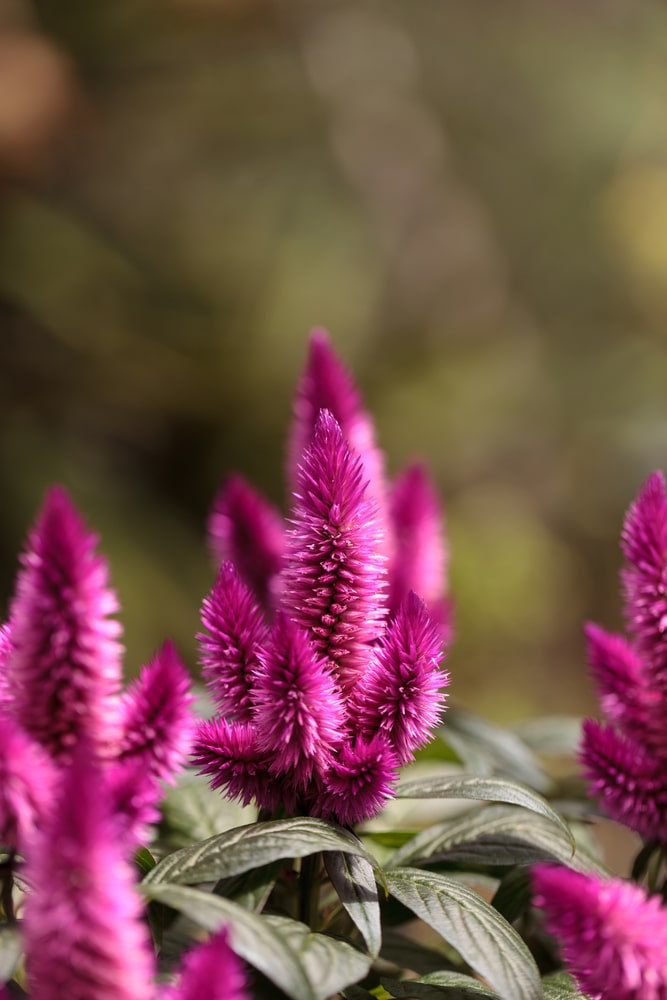
2. PETUNIA
When talking annual flowers, I think the first flower that comes to mind is the beautiful and prolific petunia! This flower shines as a container plant and for good reason.
Its flower blooms are plentiful if grown in full sun as well as fertilized and deadheaded regularly.
You can find it in a variety of rich colors and patterns, too.
Petunias are ideal for hanging baskets, containers, and even garden beds. This is an incredibly long-blooming plant, blooming from spring until the first frost, which makes it absolutely worth the money.
HARDINESS ZONE: grown as an annual in most zones
SUNLIGHT: Full sun
SOIL: Well-draining mix
BLOOM TIME: Spring, summer, fall
WATER: Water containers daily
PRUNING: Deadhead the spent blooms regularly to encourage more blooms
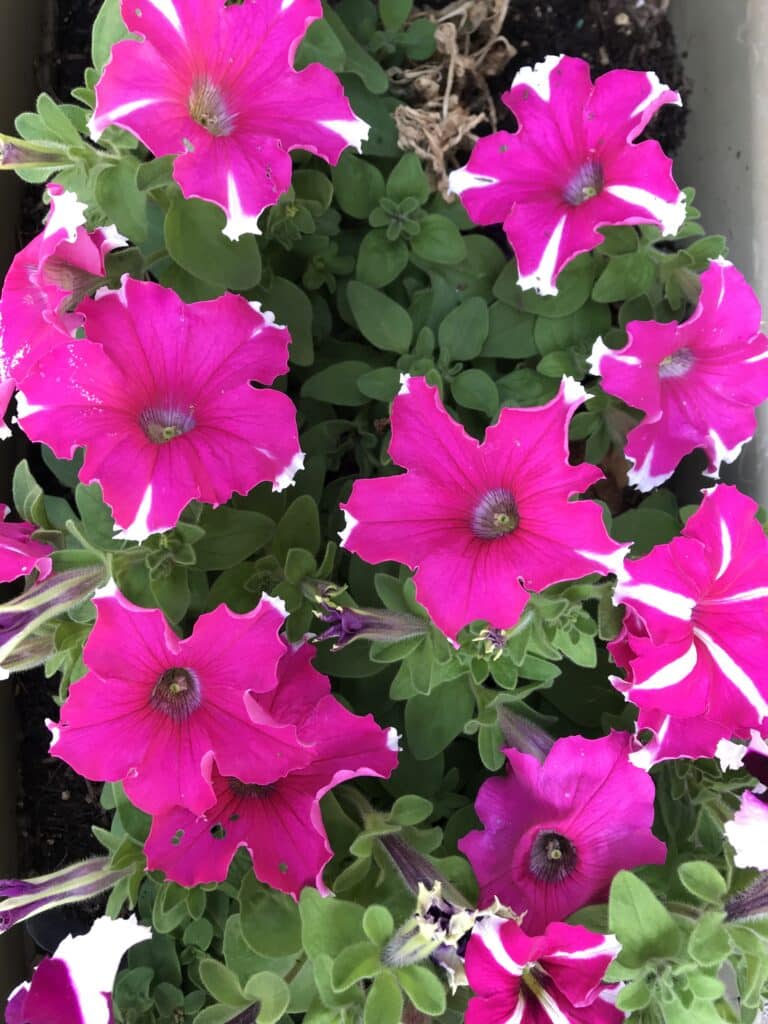
3. PORTULACA aka MOSS ROSE
You’ve likely seen Moss Rose at the garden center; it’s a popular plant and one that many succulent lovers are drawn to because of its fleshy leaves.
Both heat and drought-tolerant, this plant features beautiful green foliage and lovely small flowers that resemble roses.
It’s most often grown as a ground cover because of its low height or used as a filler in containers.
Portulaca is a fast grower and can spread out quickly to cover bare spots in your landscape.
HARDINESS ZONE: Grown in most zones as annuals. Hardy in zones 10-11
SUNLIGHT: Full sun. Flowers don’t open in the shade
SOIL: Loose and well-draining mix
BLOOM TIME: Summer to frost
WATER: Sensitive to overwatering. Water when the soil feels dry.

4. GLOBE AMARANTH
If you’re looking for a unique plant that produces generous flower blooms over many months, this is it!
It’s a very tough plant that pops with rich color and feeds pollinators and butterflies.
Its flower blooms resemble small round pompoms and they’re often used as dried flowers in decorative arrangements.
This might be the most heat-resistant annual on this list!
HARDINESS ZONE: Grown in most zones as annuals. Hardy in zones 10-11
SUNLIGHT: Full sun. Doesn’t bloom as much if kept in the shade
SOIL: Well-draining mix
BLOOM TIME: Summer to frost
WATER: Water regularly for best results
PRUNING: Deadhead to encourage more blooms
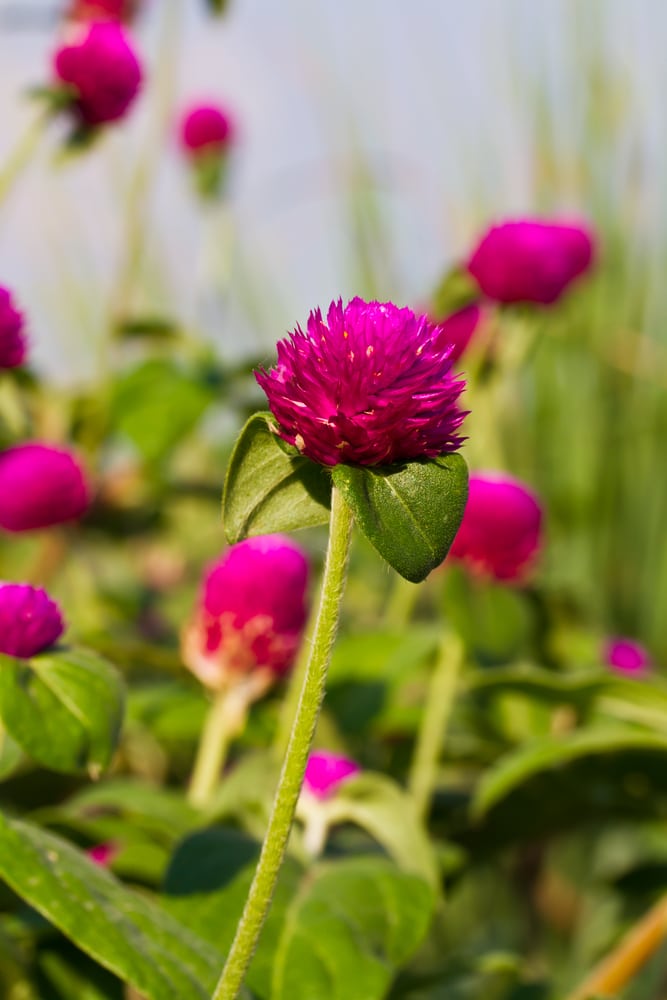
5. COSMOS aka cosmos bipinnatus
Cosmos are another popular garden annual. They come in many different colors and can bloom quite vigorously if deadheaded regularly.
This flowering annual does best in full sun, as it won’t flower as much if kept in the shade. You’ll enjoy a long bloom period with these annuals since they’re able to bloom from summer to fall!
Grow them in containers and hanging baskets or in a cutting garden. You can find both short and taller varieties to suit your garden needs.
Native to Mexico, cosmos are very drought-tolerant. They can withstand both high temperatures and long periods of little water.
HARDINESS ZONE: Grown in most zones as annuals. Hardy in zones 10-11
SUNLIGHT: Full sun
SOIL: Can tolerate poor soils, sandy soil, clay soil, and well-draining mix
BLOOM TIME: Mid-summer to frost
WATER: Water regularly for best results
PRUNING: Deadhead to encourage more blooms
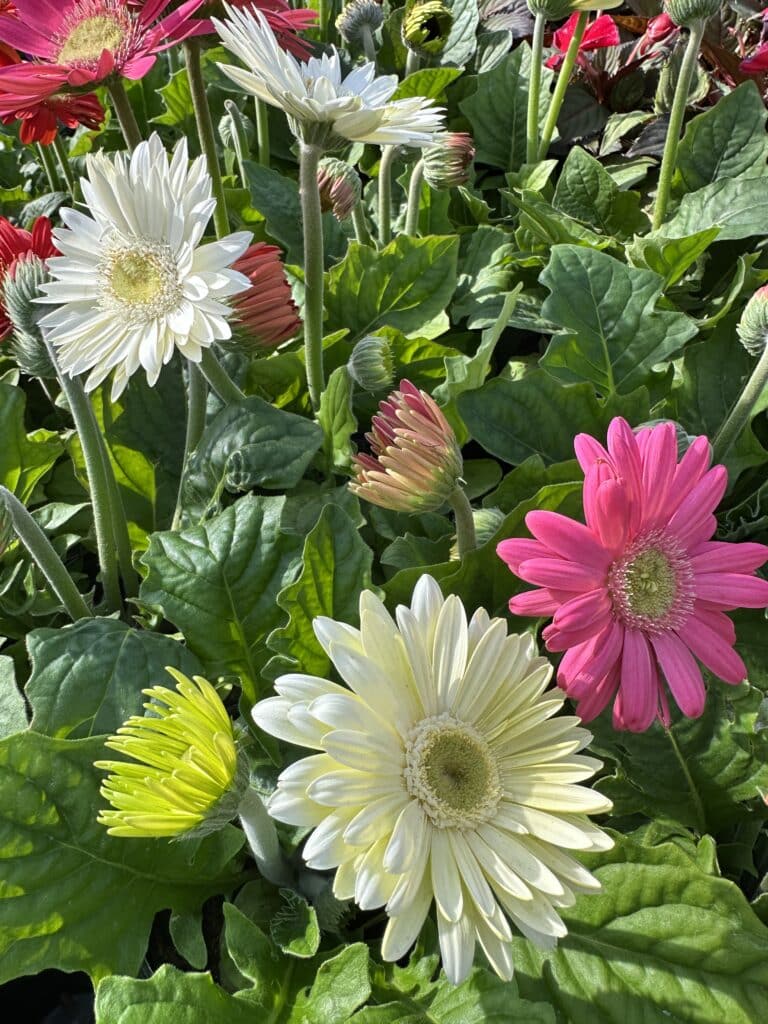
6. ZINNIA ELEGANS
Zinnias are among the most beloved annual flowers because of their lovely flower blooms. They’re also among the best heat-loving annuals.
Celebrated for its low-maintenance nature, the zinnia flower is perfect for beginners who have never cared for flowers before.
You can grow them in the ground or in containers or save money by growing them from seed.
Their flower petals can either be “singles” with just one row of petals around the center, semi-doubles, or doubles, with two rows of petals.
Use them in your flower arrangements for added height, as they can last quite a long time inside a vase of water.
Native to Mexico and South America, zinnias are drought-tolerant and sensitive to overwatering. Many consecutive days of rain can do some damage and lead to powdery mildew, unfortunately.
HARDINESS ZONE: 3-10
SUNLIGHT: Full sun
SOIL: Can tolerate poor soils, sandy soil, clay soil, and well-draining mix
BLOOM TIME: Spring, summer, fall
WATER: Water when soil is dry
PRUNING: Deadhead to encourage more blooms
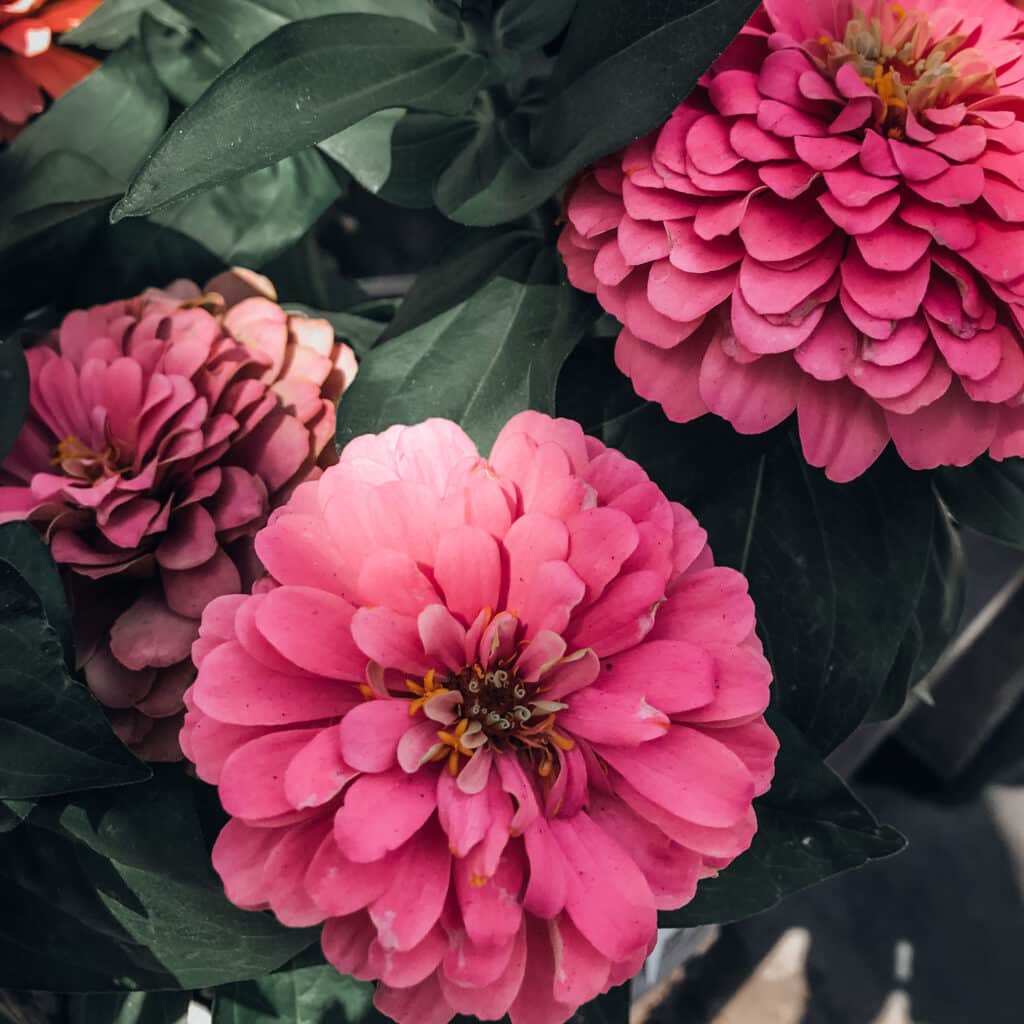
7. FRENCH MARIGOLD
French Marigold is a stunner in the garden and one of the most heat-resistant annuals you can grow. It’s known for being very low-maintenance, so it’s a great choice for beginner gardeners.
It’s also a prolific bloomer; it’ll continue to bloom month after month from spring to frost.
Give this heat-loving annual plenty of full sun to keep it happy and encourage more blooms. It will not grow very many flower buds if planted in full or partial shade. The more sun, the better.
You can find French marigolds with single-row petals or fluffier varieties with double blooms.
HARDINESS ZONE: 2-11
SUNLIGHT: Full sun
SOIL: Well-draining mix
BLOOM TIME: Spring, summer, fall
WATER: Water when soil is dry. Doesn’t like soggy soil.
PRUNING: Deadhead to encourage more blooms
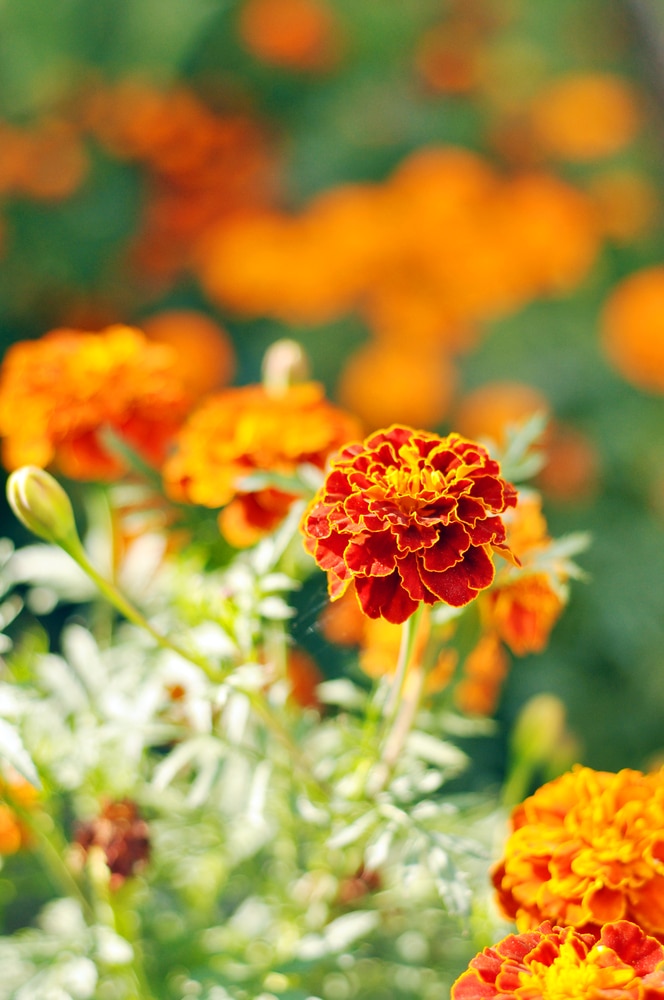
8. LANTANA
Lantana is among the toughest annual plants you’ll find at the garden center. It thrives in full sun and hot temperatures.
Its foliage is evergreen and its tiny flower blooms burst with a mix of bright colors like orange and red. This is an annual that pulls its weight in the garden!
If you crave a lovely flower that feeds bees, hummingbirds, and butterflies, then plant a few Lantana plants in the ground or in your containers!
They are, however, toxic to animals, so plant wisely.
HARDINESS ZONE: 2-11
SUNLIGHT: Full sun
SOIL: Well-draining mix
BLOOM TIME: Spring, summer, fall
WATER: Water when soil is dry. Doesn’t like soggy soil.
PRUNING: Deadhead to encourage more blooms
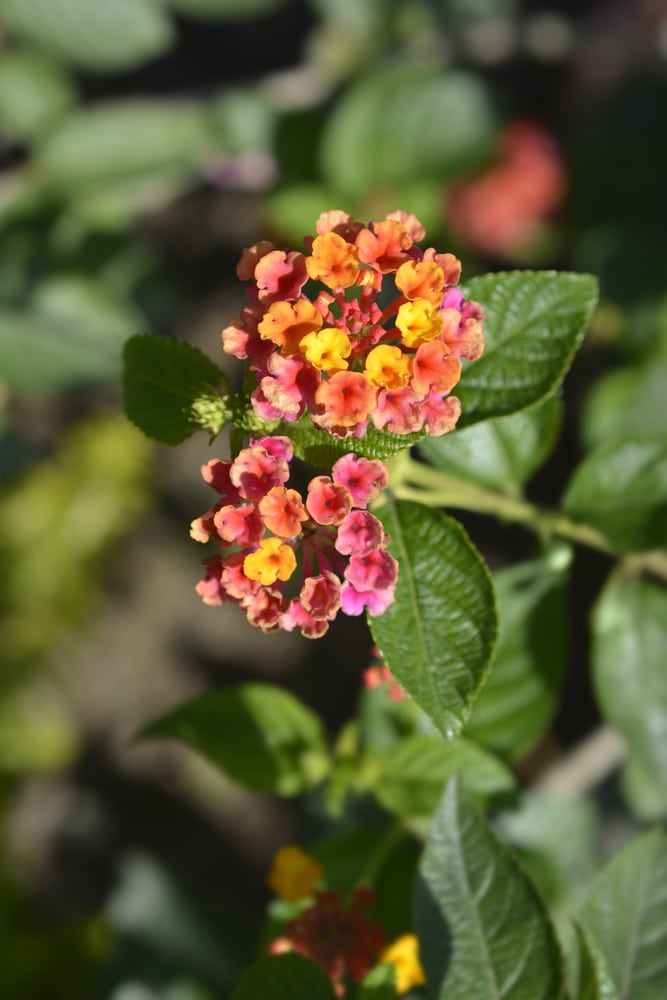
9. ANGELONIA
Angelonia is grown as a perennial in warm climates but grown as an annual elsewhere. This is one of the most beautiful flowers in the garden and also makes an excellent cut flower for bouquets and vases.
The orchid-like flower blooms come in a variety of colors including purple, pink, and white.
Plant angelonia in a full sun area: this annual flower needs plenty of sunshine to produce its blooms. Otherwise, you won’t see the flower buds it’s famous for.
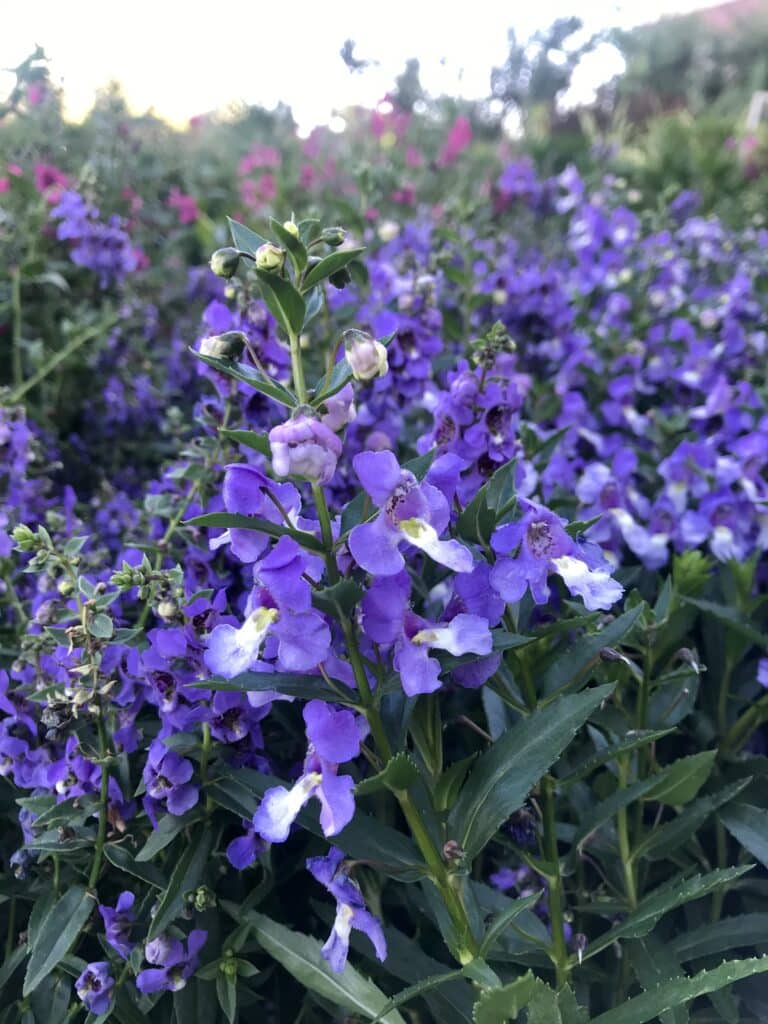
10. SWEET ALYSSUM
Commonly called “Snow Princess”, sweet alyssum features tiny but plentiful clusters of white flower blooms. It’s the workhorse of many gardens!
Because of its low-growing nature, sweet alyssum is one of the most ideal annual flowers for growing in containers and hanging baskets because it serves as a gorgeous “filler”. It complements other colors very well.
However, it can also be grown in the front of garden beds and along walkways.
While this annual flower loves the sun and heat, it’s important to keep it well-watered.
For this reason, try planting it in a large container that can hold a lot of soil. Small containers dry out too quickly for this plant.
HARDINESS ZONE: Grown as an annual in zones 2-8, short-lived perennial in zones 9-11
SUNLIGHT: Full sun
SOIL: Well-draining mix
BLOOM TIME: Spring through first frost
WATER: Water when the soil is dry. Don’t let the soil stay dry for long.
PRUNING: No deadheading is needed for newer hybrids.
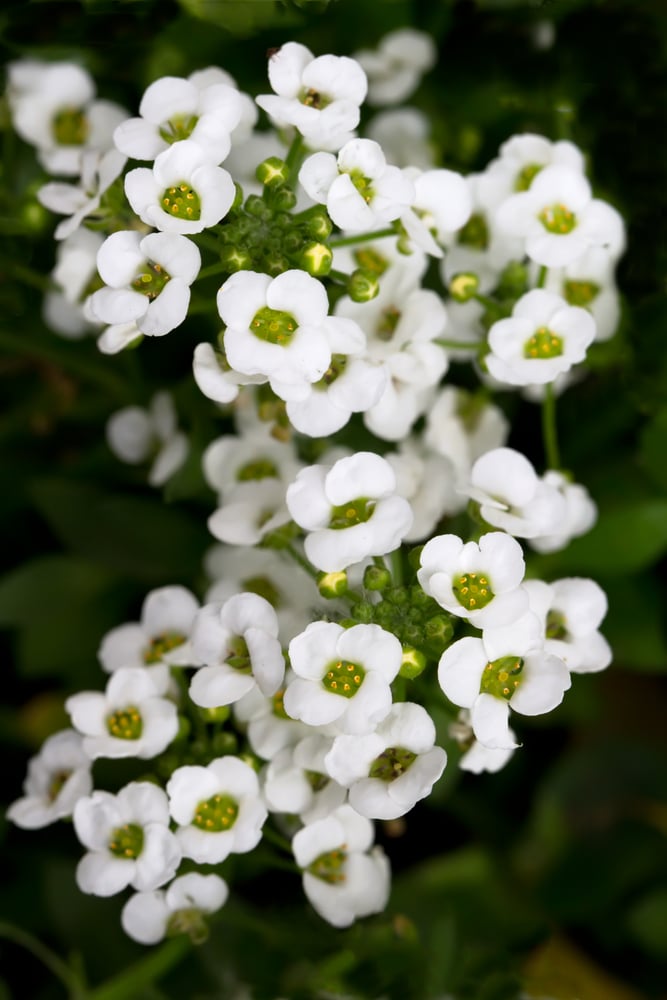
11. SUNFLOWER
Sunflowers are one of the most well-known flowers. They love the sun and need it in order to grow upright and produce large flowers.
While they can tolerate drought, they perform better when watered regularly because consistent moisture helps to set their blooms.
You might have to stake sunflowers to help them grow upright and avoid toppling over during times of heavy wind.
Sunflowers can be grown in containers as long as you use a large enough container.
HARDINESS ZONE: 2-11
SUNLIGHT: Full sun
SOIL: Well-draining mix
BLOOM TIME: Summer, fall
WATER: Water when the soil is dry
PRUNING: No deadheading is needed for newer hybrids.
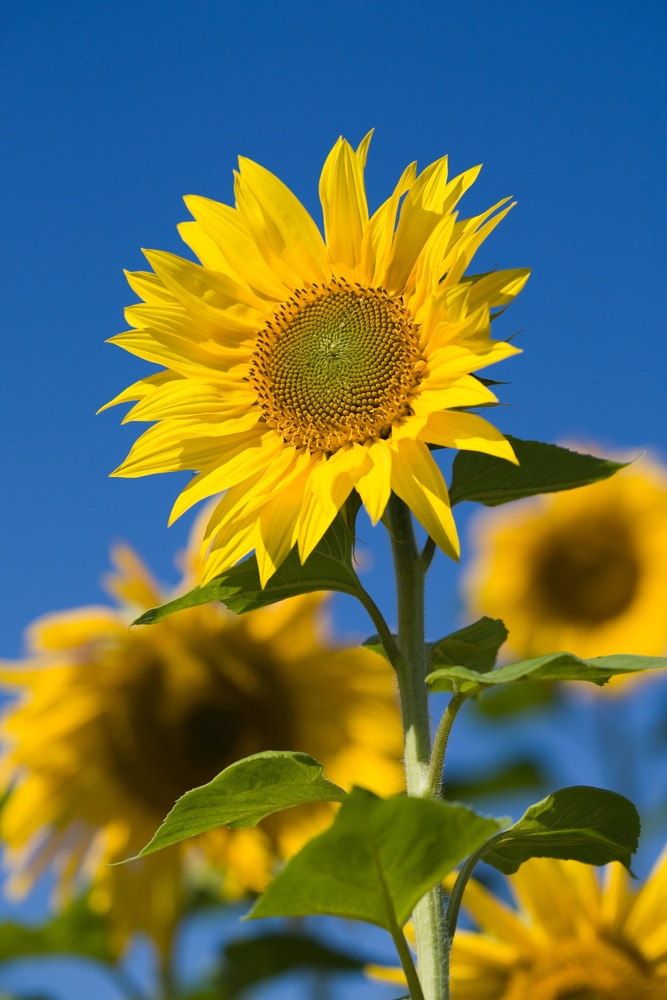
12. SUNPATIENS
An exciting hybrid of the shade-loving impatiens, SunPatiens were adapted to thrive in heat and humidity. They are also larger, bushier, and more prolific!
Plant this beauty in your garden beds or containers if you’re looking for long-lasting blooms. It can grow up to 2 feet tall and wide!
Grow sunpatiens in a variety of colors including red, orange, lavender, and white.
These fast-growing annuals will grow more blooms when grown in full sun and pinched back regularly.
HARDINESS ZONE: Grown as an annual in most zones, perennial in warm climates
SUNLIGHT: Full sun
SOIL: Sandy, well-draining mix
BLOOM TIME: spring through fall
WATER: Water daily until established, then water when the soil is dry
PRUNING: No deadheading is needed but it does encourage more blooms
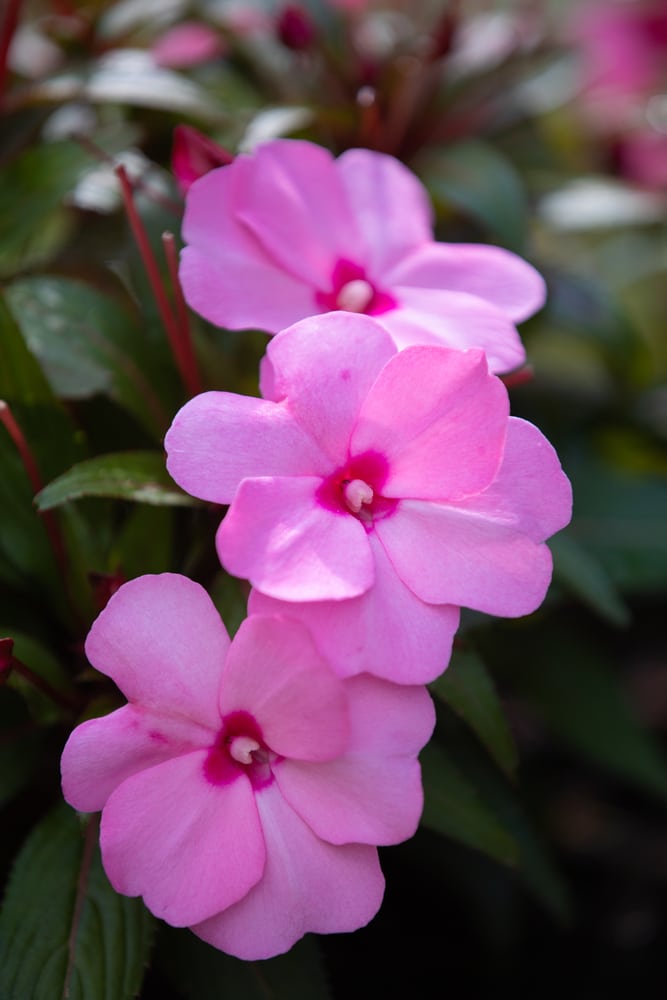
13. AGERATUM
A rare flower because of its true blue color, ageratum is always a sought-after annual. Sporting a unique look, it features pompom-shaped flower blooms that grow in clusters.
They can be found in shades of blue, white, pink, red, and lavender. You can also find tall and short varieties to fit your needs.
Taller varieties can be planted in the middle of a garden bed, while shorter types look best in the front of the bed.
You’ll need to water regularly, though, since they have short root systems that can dry out quickly during periods of intense heat.
HARDINESS ZONE: 2-11
SUNLIGHT: Full sun
SOIL: Sandy, well-draining mix
BLOOM TIME: Spring through fall
WATER: Don’t let the soil dry out for too long
PRUNING: Deadhead to encourage new flowers
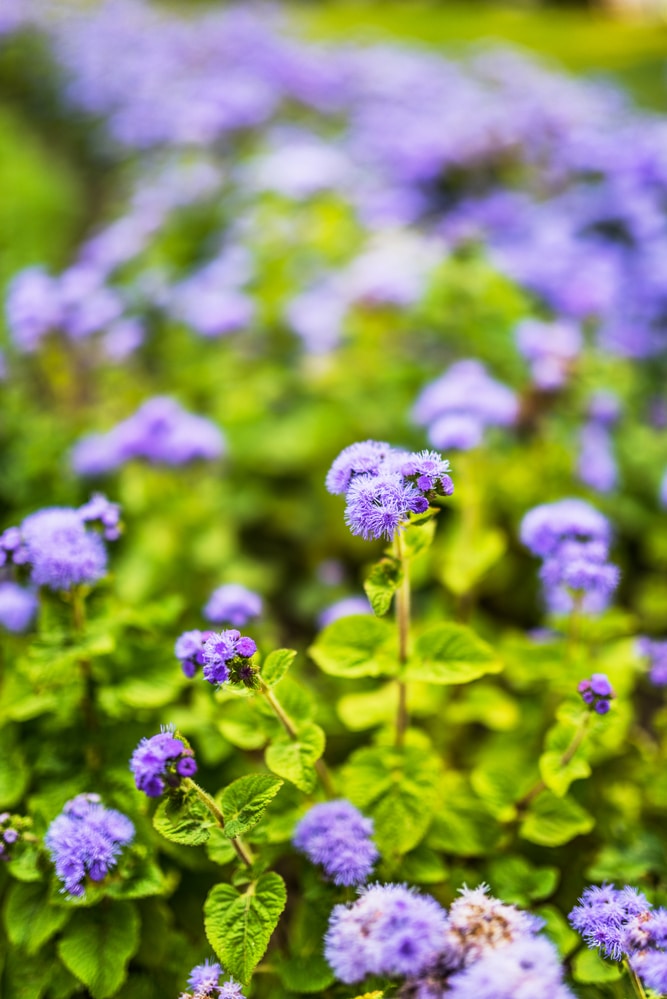
14. PERIWINKLE AKA VINCA
Periwinkle flowers are a garden classic.
This flower is most often grown as an annual in most zones and as a perennial in warm climates. Use it as a ground cover or as a filler in your containers.
As it grows, it can become a vining flower.
It performs best in full sun and won’t produce as many blooms if left in full or even partial shade. Also drought-tolerant, this annual is perfect for beginner gardeners.
It can be found in colors of white, red, pink, and mauve. Be careful where you plant, as all parts of this annual are toxic to pets and people.
HARDINESS ZONE: Grown as an annual in zones 2-7, hardy perennial in zones 9-11
SUNLIGHT: Full sun
SOIL: Sandy, well-draining
BLOOM TIME: Spring through fall
WATER: Don’t let the soil dry out for too long
PRUNING: Deadhead to encourage new flowers
I hope you’ve enjoyed reading about these heat-resistant annuals and hope it’s inspired you to go out and start planting them in your garden beds and containers!

WANT TO REMEMBER THIS? SAVE THIS TUTORIAL ON THE BEST HEAT-RESISTANT ANNUALS ON YOUR FAVORITE PINTEREST BOARD!
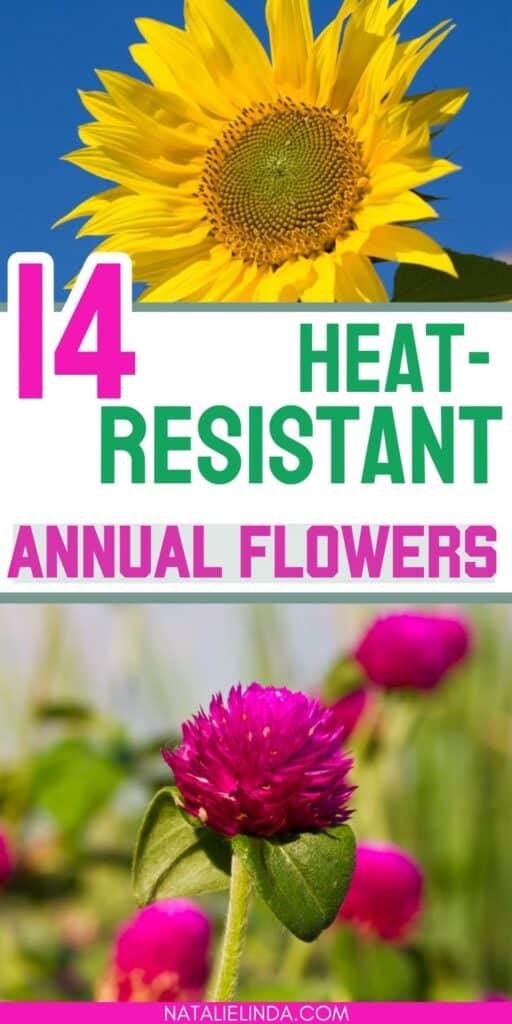
WANT TO LEARN MORE ABOUT OTHER ANNUALS?
Be sure to check out these posts for additional inspiration:
16 Annuals that Bloom ALL Summer Long
How to Grow a Cut Flower Garden
How to Care for Chrysanthemums
The Important Differences Between Annuals vs Perennials
How to Care for Cyclamen
11 Gorgeous Plants that Will Repel Mosquitoes